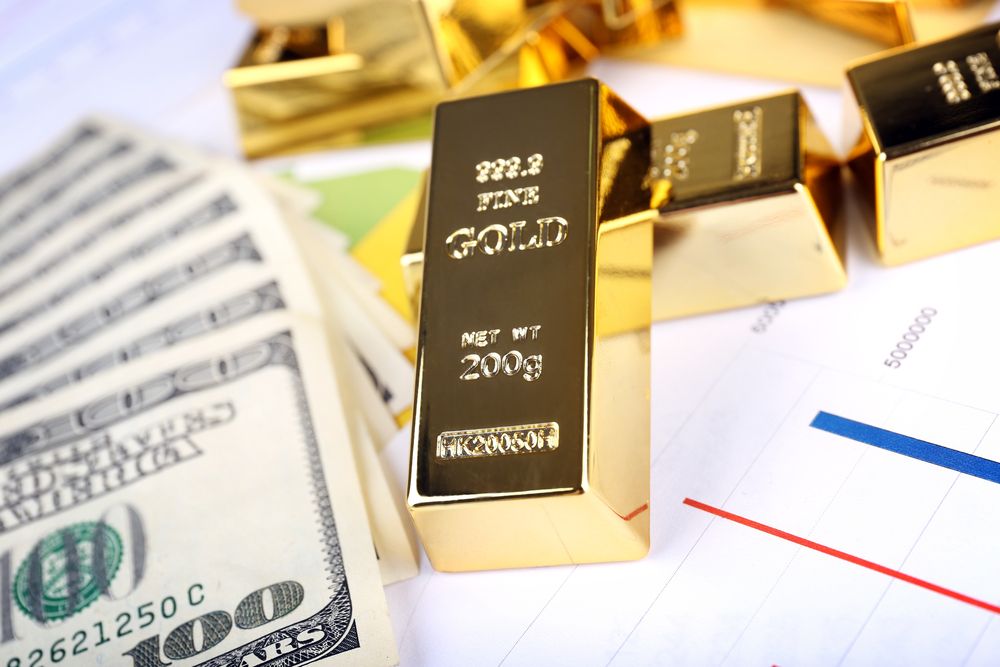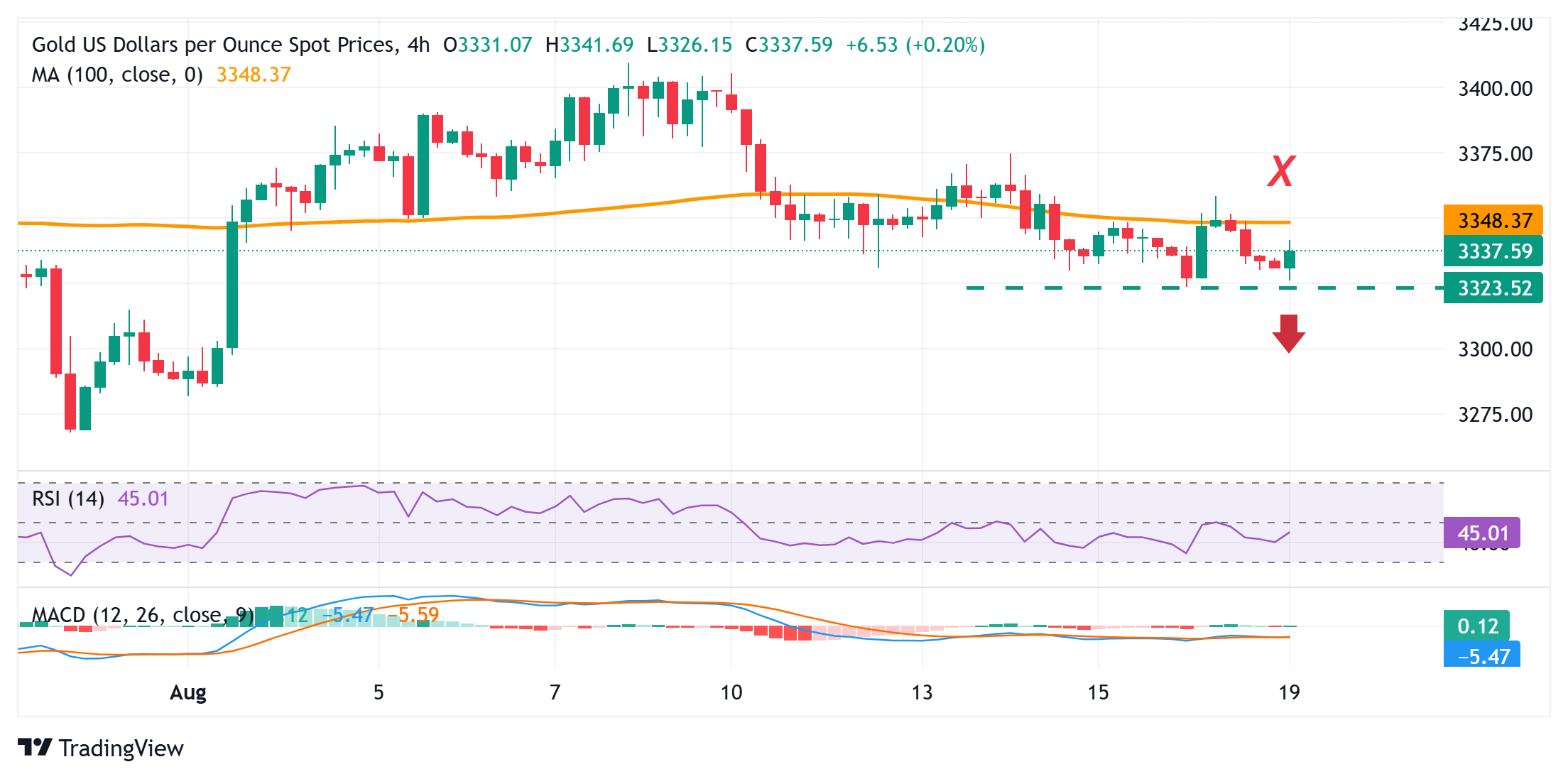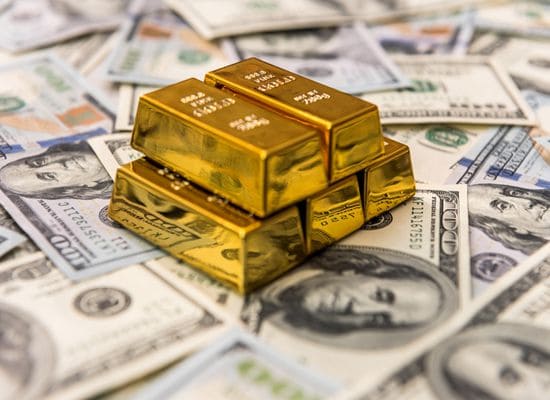Gold lacks bullish conviction amid reduced Fed rate-cut bets and peace hopes


- Gold gains some positive traction during the Asian session, though the uptick lacks follow-through.
- Reduced bets for a 50 bps Fed rate cut in September underpin the USD and cap the XAU/USD pair.
- Hopes for a Russia-Ukraine peace deal might contribute to keeping a lid on the precious metal.
Gold (XAU/USD) attracts some dip-buying during the Asian session on Tuesday and moves away from an over two-week low touched the previous day. The growing acceptance that the US Federal Reserve (Fed) will resume its rate-cutting cycle in September turns out to be a key factor offering some support to the non-yielding yellow metal. Apart from this, the cautious market mood drives some safe-haven flows towards the commodity.
Meanwhile, the US Dollar (USD) is looking to build on the previous day's positive move amid diminishing odds for a more aggressive policy easing by the US central bank. Apart from this, hopes for a Russia-Ukraine peace deal might contribute to capping the upside for the non-yielding Gold. The XAU/USD bulls might opt to wait for the FOMC Minutes on Wednesday and Fed Chair Jerome Powell's speech at the Jackson Hole Symposium.
Daily Digest Market Movers: Gold benefits from bets for an imminent rate cut by the Fed in September
- Traders trimmed their bets for a jumbo interest rate cut by the Federal Reserve in September following last Thursday's release of a hotter US Producer Price Index, which rose in July at the fastest monthly pace since 2022. Moreover, the preliminary data from the University of Michigan showed on Friday that the one-year inflation expectations climbed to 4.9% from 4.5% and the five-year forecast increased to 3.9% from 3.4%.
- The data indicates a gain of momentum in price pressures and backs the case for a hawkish Fed, which, in turn, is seen acting as a headwind for the non-yielding Gold. Traders, however, are still pricing in a nearly 85% chance that the US central bank will lower borrowing costs in September and deliver at least two 25 basis points rate cuts by the year-end. This keeps a lid on the US Dollar and lends support to the commodity.
- Meanwhile, the S&P Global Ratings agency affirmed the US 'AA+/A-1+' sovereign ratings while maintaining a ‘Stable’ outlook on steady, albeit high, deficits. The agency expects US net general government debt to approach 100% of GDP, given structurally rising nondiscretionary interest and aging-related expenditure. The agency further noted that the outlook indicates fiscal deficit outcomes won't meaningfully improve, but doesn't project persistent deterioration over the next several years.
- On the geopolitical front, Russian President Vladimir Putin has agreed to meet Ukrainian President Volodymyr Zelenskyy for a peace summit. This raises hopes for a breakthrough towards ending the protracted Russia-Ukraine war and might cap any meaningful appreciation for the safe-haven precious metal. Traders might also opt to wait for more cues about the Fed's rate-cut path before placing fresh directional bets.
- Hence, the focus will remain glued to the release of the FOMC meeting Minutes on Wednesday and Fed Chair Jerome Powell's speech at the Jackson Hole Symposium. Apart from this, traders will take cues from flash PMI prints on Thursday, which will be looked to for fresh insight into the global economic health. This, in turn, might infuse some volatility around the XAU/USD pair during the latter part of the week.
- In the meantime, Tuesday's US housing market data – Building Permits and Housing Starts – might do little to influence the precious metal. That said, comments from influential FOMC members would drive the USD demand, which, along with the broader risk sentiment, should contribute to producing short-term trading opportunities around the XAU/USD pair.
Gold is likely to confront a stiff hurdle near 200-SMA on H4, currently pegged ahead of $3,350

Slightly negative technical indicators on 4-hour/daily charts warrant some caution for bulls or positioning for any meaningful appreciating move in the near-term. Hence, any subsequent move up is more likely to confront stiff resistance near the 200-period Simple Moving Average (SMA) on the 4-hour chart, currently pegged around the $3,347-3,348 region. This is followed by the overnight swing high, around the $3,358 area, above which the XAU/USD pair could climb to the $3,372-3,374 region. The momentum could extend further and allow the Gold price to reclaim the $3,400 mark before aiming to test the monthly peak, around the $3,408-3,410 area.
On the flip side, the $3,325-3,323 zone, or over a two-week low touched on Monday, could offer immediate support ahead of the $3,310-3,300 region. Acceptance below the said handle could make the XAU/USD pair vulnerable to accelerate the fall towards the $3,283-3,282 horizontal zone before dropping to the late June swing low, around the $3,268 region. The latter represents the lower boundary of a nearly three-month-old trading range, and a convincing break below will be seen as a fresh trigger for bearish traders.
Gold FAQs
Why do people invest in Gold?
Gold has played a key role in human’s history as it has been widely used as a store of value and medium of exchange. Currently, apart from its shine and usage for jewelry, the precious metal is widely seen as a safe-haven asset, meaning that it is considered a good investment during turbulent times. Gold is also widely seen as a hedge against inflation and against depreciating currencies as it doesn’t rely on any specific issuer or government.
Who buys the most Gold?
Central banks are the biggest Gold holders. In their aim to support their currencies in turbulent times, central banks tend to diversify their reserves and buy Gold to improve the perceived strength of the economy and the currency. High Gold reserves can be a source of trust for a country’s solvency. Central banks added 1,136 tonnes of Gold worth around $70 billion to their reserves in 2022, according to data from the World Gold Council. This is the highest yearly purchase since records began. Central banks from emerging economies such as China, India and Turkey are quickly increasing their Gold reserves.
How is Gold correlated with other assets?
Gold has an inverse correlation with the US Dollar and US Treasuries, which are both major reserve and safe-haven assets. When the Dollar depreciates, Gold tends to rise, enabling investors and central banks to diversify their assets in turbulent times. Gold is also inversely correlated with risk assets. A rally in the stock market tends to weaken Gold price, while sell-offs in riskier markets tend to favor the precious metal.
What does the price of Gold depend on?
The price can move due to a wide range of factors. Geopolitical instability or fears of a deep recession can quickly make Gold price escalate due to its safe-haven status. As a yield-less asset, Gold tends to rise with lower interest rates, while higher cost of money usually weighs down on the yellow metal. Still, most moves depend on how the US Dollar (USD) behaves as the asset is priced in dollars (XAU/USD). A strong Dollar tends to keep the price of Gold controlled, whereas a weaker Dollar is likely to push Gold prices up.






